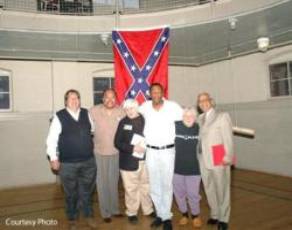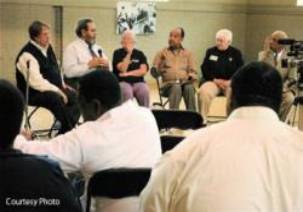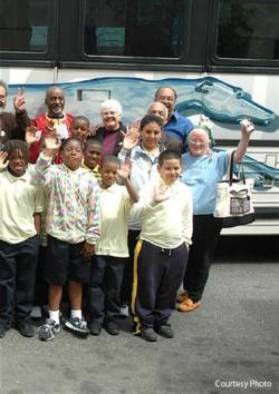|
Joan C. Browning – Freedom Rider
Capture
the Moment: Freedom Riders Teach from
Their Experiences
By Joseph Young, staff writer, The Washington Informer
Danger and fear mingled at Parchment
Penitentiary where the Freedom Riders, who rode buses from Washington to
Mississippi 46 years ago to challenge segregation on interstate buses and
terminals, were placed behind bars.
The jailers separated the diverse group by gender and race, and they were
left isolated in private fear with no fixed point of reference.
The Freedom Riders rode buses from Washington
to Mississippi 46 years ago to challenge segregation on interstate buses and
terminals. They were all incarcerated in Mississippi’s Parchman State work
farm prison, maximum security - some for almost two months, for sitting in
the 'white' or 'colored' section.
“In a sense, you really didn’t know what was
going on in certain experiences,” said Reginald Green, who was preparing for
the ministry at Virginia Union before he joined the Freedom Riders. “But you
had yourself to focus on.”
Joan Browning, a White Freedom Rider who grew up in Georgia, told of fearing
the jailers would rape or murder her when she was confined in an Albany city
jail.
“All through the night White men came, shinning flash lights at me as if I
were a museum object,” said Browning.
|
(l to r) Author Ray Arsenault,
civil rights veteran Lawrence Guyot and Freedom Riders Joan Mulholland,
Dion Diamond, Joan Browning and Reginald Green at the Thurgood Marshall
Center in Northwest.
|

|
Browning, who was put in a cell alone, distracted herself by writing notes
about her experiences and how she felt. She could drop the fear that was to
be expected, but her objectification by jailers from person to thing was
unthinkable.
At a two-day forum last weekend at the Thurgood Marshall Center in Northwest,
Browning, 64, and Green, 68, gathered with two other local Freedom Riders, to
share their experience with elementary school students. They told students
about their freedom ride and encouraged the young people to feel proud of
their heritage and enthusiastic about their responsibility to contribute to
society. The Freedom Riders strained for insight lost forever to quick
recall.
|

|
At a two-day forum last Friday and
Saturday at the Thurgood Marshall Center in Northwest, Freedom Riders told
students about their dangers and fears during the ride.
|
More lasting, however, will be a documentary
produced by Steven Nero, who coordinated the reunion. He
organized the gathering with help of an $1800 grant from the D.C. Humanities
Council and the African American Civil War Foundation.
“They are unsung heroes,” Nero, 53, said. “It just dawned on me that these
are people that you sit right next to or live right next to, and you have no
idea that they went to jail for 40 days in maximum security, took a 25-five
hour bus ride from D.C. to go get arrested and possibly killed.” He believes
these stories need to be told. “I also believe there is something to learn
from their courage,” he added.
Author Raymond Arsenault, who wrote “Freedom Riders: 1961 and the Struggle
for Racial Justice,” moderated the forum. Also joining the panel discussion
was Lawrence Guyot, active in civil rights and one of the original Student
Nonviolent Coordinating Committee members.
Other Freedom Riders at the forum included
Joan Mulholland, 65, who is White and now a teacher’s aide in Alexandria. She
arrived in Mississippi in 1961 and was arrested for civil rights activities.
She spent the summer at Hines County jail.
“There were people who were violently and unalterably opposed to what we were
doing,” she said. They were considered “Whites in the movement…as traitors.”
She recalled hearing, “the only thing worst than a nigger was a nigger
lover.”
Dion Diamond, a Howard University student majoring in physics, was active in
the civil rights movement before he joined the Freedom Riders.
“Here is this little punk kid, [who said], ‘you nigger,’” Diamond remembered.
He recalled a time when he was picketing at a lunch counter in Arlington,
Virginia. “Of course, what I really wanted to do was punch him,” Daimond
said.
|

|
More Freedom Rider's photographs by
Steven Nero and displays of Freedom Riders artifacts can be seen at the
African American Civil War Museum, 1200 U St., N. W., Wash., D.C. through
June 2.
In 1960, a year prior to the Freedom Rides, the Supreme Court had outlawed
segregation on interstate buses and facilities, but Southern states such as
Mississippi, Georgia and Alabama refused to enforce the ruling.
Although Attorney General Robert Kennedy didn’t support the Freedom Riders,
the bravery of the student activists so stirred the nation, by the fall of
1961, Kennedy issued an injunction requiring Southern states to enforce the
federal ruling.
“So much for federalism,” said Guyot, co-author of “Putting the Movement
back in Civil Rights Teaching.”
|
“Racism is real, but it doesn’t have to be
stultifying,” Guyot said. “It does not have to be a condition of limitation.
I look at it as a condition of opportunity.”
For much more, including excerpts from the
forum with the four local Freedom Riders as they discussed their experiences
in the civil rights movement, please visit us online at www.washingtoninformer.com.
|







